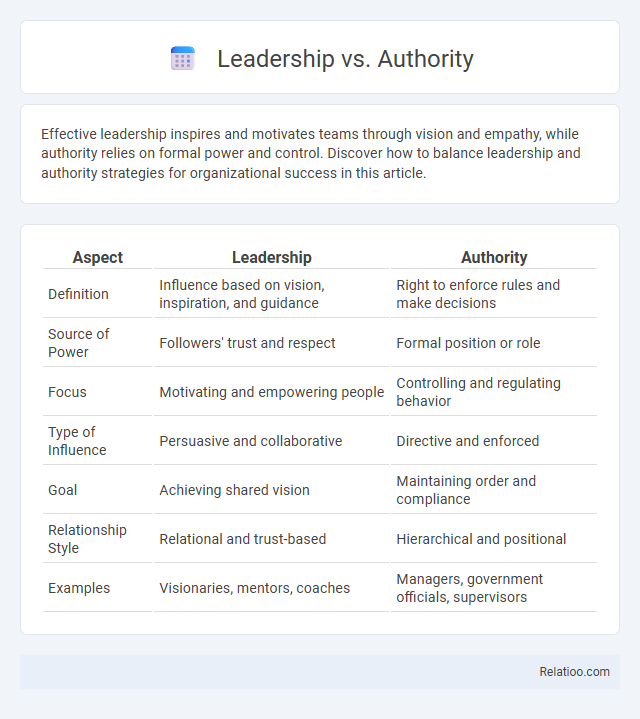Effective leadership inspires and motivates teams through vision and empathy, while authority relies on formal power and control. Discover how to balance leadership and authority strategies for organizational success in this article.
Table of Comparison
| Aspect | Leadership | Authority |
|---|---|---|
| Definition | Influence based on vision, inspiration, and guidance | Right to enforce rules and make decisions |
| Source of Power | Followers' trust and respect | Formal position or role |
| Focus | Motivating and empowering people | Controlling and regulating behavior |
| Type of Influence | Persuasive and collaborative | Directive and enforced |
| Goal | Achieving shared vision | Maintaining order and compliance |
| Relationship Style | Relational and trust-based | Hierarchical and positional |
| Examples | Visionaries, mentors, coaches | Managers, government officials, supervisors |
Defining Leadership and Authority
Leadership embodies the ability to inspire and guide individuals toward achieving collective goals through influence, vision, and motivation. Authority refers to the formal power granted to individuals or institutions to enforce rules, make decisions, and command obedience within a structured hierarchy. Defining leadership emphasizes relational and inspirational dynamics, while authority centers on legitimacy, control, and sanctioned power.
Core Differences Between Leadership and Authority
Leadership involves inspiring and influencing others to achieve common goals through vision and motivation, while authority is the formal power granted by a position or role to enforce rules and make decisions. Leadership thrives on trust, communication, and personal influence, whereas authority relies on organizational structure and official mandates. Understanding these core differences helps you leverage both qualities effectively to drive team performance and organizational success.
The Role of Influence in Leadership
Leadership hinges on influence, inspiring followers through vision and emotional connection rather than positional power. Authority grants formal power to enforce decisions and command compliance within defined structures, but lacks intrinsic motivational impact found in authentic leadership. Effective leadership blends influence with authority, leveraging respect and trust to guide behavior beyond mere obedience.
Authority: Power by Position
Authority represents power derived from an official position within an organization, granting the ability to make decisions, enforce rules, and command resources. Unlike leadership, which depends on influence and interpersonal skills, authority relies on formal roles encoded in organizational hierarchies, such as managers, executives, or government officials. This positional power enables compliance and organizational order but does not inherently inspire motivation or commitment from subordinates.
Leadership without Formal Authority
Leadership without formal authority relies on influence, trust, and communication rather than positional power to guide and motivate others. You can inspire collaboration and drive change by building strong relationships and demonstrating expertise, even without official titles or organizational hierarchy. This form of leadership empowers individuals to act autonomously while fostering a shared vision and commitment.
Decision-Making: Leaders vs Authoritarians
Leaders prioritize collaborative decision-making, valuing input from team members to foster innovation and commitment. Authoritarians rely on unilateral decisions, enforcing rules strictly to maintain control and ensure compliance. Effective leadership balances authority with empathy, empowering teams while guiding strategic direction.
Building Trust: Leaders vs Authorities
Leadership builds trust through empathy, transparency, and consistent actions that inspire confidence and loyalty, whereas authority relies on formal power and positional control to enforce compliance. Your ability to foster genuine relationships and demonstrate integrity distinguishes leaders who cultivate trust from authorities who command obedience. Trust emerges from the leader's commitment to shared values and open communication, not merely from the exercise of authority.
Impact on Organizational Culture
Leadership shapes organizational culture by inspiring trust, fostering collaboration, and promoting innovation, which leads to enhanced employee engagement and adaptability. Authority establishes structure and enforces rules, creating stability but potentially limiting creativity if applied rigidly. The balance between leadership and authority determines whether the culture is dynamic and empowering or controlled and compliance-driven.
Developing Leadership Skills Beyond Authority
Developing leadership skills beyond authority empowers you to inspire and motivate others without relying solely on positional power, fostering trust and collaboration within your team. Effective leadership integrates emotional intelligence, communication, and vision, creating influence that transcends formal authority. By focusing on these skills, your impact grows through relationships and example rather than command.
Balancing Leadership and Authority for Success
Balancing leadership and authority is crucial for success, as effective leaders inspire and motivate their teams while using authority to establish clear expectations and maintain order. Your ability to blend empathetic communication with decisive decision-making fosters trust and drives performance. Striking this balance ensures sustainable influence and organizational achievement.

Infographic: Leadership vs Authority
 relatioo.com
relatioo.com